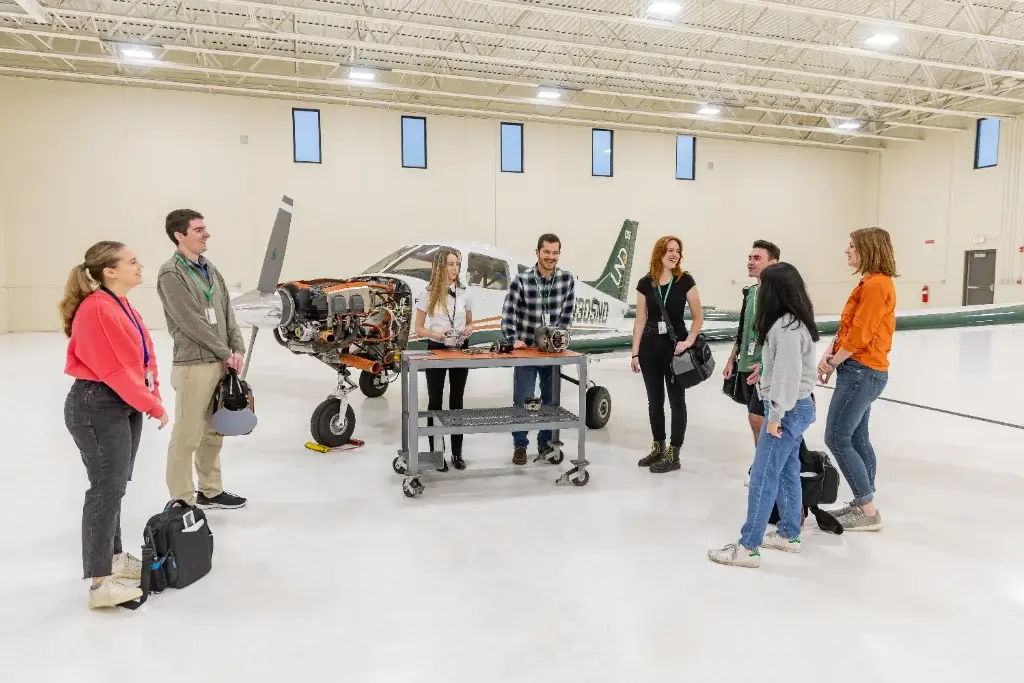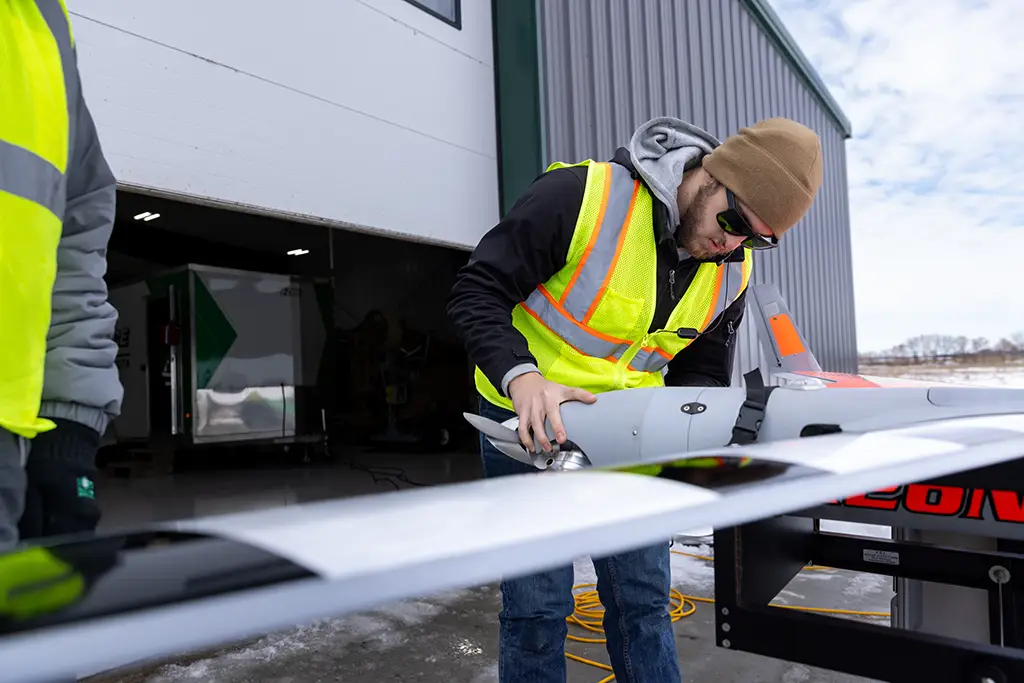
Is Aerospace Engineering Difficult? What You Should Know
While aerospace engineering presents complex challenges, those with a genuine passion for the discipline find it immensely rewarding.
Request Information
With dedication and perseverance, navigating the intricacies of the field can lead to fulfilling careers and groundbreaking contributions to the aerospace industry's evolution.
Aerospace engineering, the field through which humanity's dreams of soaring through the skies and venturing into the cosmos take shape, stands as a testament to our boundless curiosity and ingenuity. From the sleek design of supersonic jets to the intricate mechanisms of interplanetary rovers, aerospace engineering plays a key role in shaping the future of air and space travel.
Yet, behind the awe-inspiring vistas of distant galaxies and the thunderous roar of rocket launches lies a world of complexities, challenges and boundless rewards. So, is aerospace engineering difficult? Read on and find out as we explore the challenges and rewards this field brings.
What is Aerospace Engineering?
Aerospace engineering is a field of engineering dedicated to the design, development, testing and production of aircraft, spacecraft and associated systems and equipment. This expansive domain encompasses both aeronautical and astronautical engineering, which are the two primary branches.
Aeronautical engineering predominantly deals with the theory, technology and practical aspects of flight within Earth's atmosphere. On the other hand, astronautical engineering focuses on the science and technology behind spacecraft and launch vehicles, including the design of spacecraft for missions beyond Earth's atmosphere, such as satellites, space probes and crewed spacecraft for exploration beyond Earth's orbit. Together, these branches of aerospace engineering push the boundaries of human exploration and technological innovation in both atmospheric and space flight.
The Challenges of Aerospace Engineering
Aerospace engineering is undeniably complex, presenting professionals in this field with various challenges. From designing aircraft capable of withstanding extreme conditions to developing spacecraft that can navigate the vastness of space, the tasks at hand require a profound understanding of physics, mathematics and engineering principles. However, it is precisely these challenges that drive innovation and propel the aerospace industry forward. Below, we'll go through some of them.
Navigating Complex Mathematics and Physics
Firstly, aerospace engineering demands a profound understanding of mathematics and physics, as these disciplines form the foundation of aircraft and spacecraft design and operation. Engineers must adeptly handle intricate mathematical equations and sophisticated physical principles to analyze, model and optimize the performance of aerospace systems.
From calculating aerodynamic forces and structural loads to simulating orbital trajectories and gravitational effects, mastery of mathematical and physical sciences is essential for ensuring the safety, efficiency and reliability of aerospace vehicles. This proficiency extends to complex areas such as fluid dynamics, thermodynamics, celestial mechanics and structural analysis, where engineers must apply advanced mathematical techniques to solve real-world engineering challenges.
Enduring Intense Academic Rigor
The field of aerospace engineering also subjects students to intense academic rigor, with coursework and curricula that demand unwavering dedication, intellectual curiosity and deep comprehension. The challenging nature of the subject matter necessitates rigorous study, critical thinking and a commitment to continuous learning.
Students are immersed in a comprehensive curriculum encompassing a wide array of disciplines, including aerodynamics, propulsion, materials science, control systems and avionics. This rigorous academic training prepares aspiring aerospace engineers to tackle complex engineering problems with confidence, resilience and a strong foundation of technical knowledge.
Innovating in Design and Problem-Solving
Creativity and innovation are at the heart of aerospace engineering, driving advancements in aircraft and spacecraft design, performance and functionality. Engineers must continually push the boundaries of technology to develop innovative solutions that address the challenges of flight within Earth's atmosphere and beyond.

Whether designing next-generation aircraft with enhanced fuel efficiency and reduced environmental impact or pioneering spacecraft for interplanetary exploration and colonization, aerospace engineers rely on their inventive spirit to conceive, develop and implement groundbreaking concepts and technologies.
This process involves brainstorming innovative design concepts, conducting feasibility studies, performing computer-aided simulations, prototyping new systems and rigorously testing prototypes to validate their performance and safety.
Mastering Advanced Technology and Software
Aerospace engineering is constantly evolving and staying on top of these technological advancements is essential for success. Engineers must continually update their skills and expertise to harness the latest tools, techniques and software applications driving innovation in the field.
From computational fluid dynamics (CFD) and finite element analysis (FEA) software to advanced materials and manufacturing processes, aerospace engineers leverage diverse cutting-edge technologies to design, analyze and optimize aerospace systems. This mastery extends beyond traditional engineering disciplines to encompass emerging fields such as artificial intelligence, machine learning, additive manufacturing and unmanned aerial systems (UAS).
By embracing new technologies and software tools, aerospace engineers enhance their capabilities, streamline design processes and accelerate the pace of innovation in aerospace engineering.
Upholding Safety and Precision Standards
Safety and precision are key in aerospace engineering, where even the smallest design flaw or operational error can have catastrophic consequences. Engineers must strictly adhere to the safety standards and regulatory requirements throughout the entire lifecycle of aerospace systems. This commitment to safety involves thorough risk assessments, failure mode analysis and reliability engineering to identify and mitigate potential hazards and ensure the robustness and resilience of aerospace vehicles.
Precision is also critical, requiring exact adherence to design specifications and manufacturing tolerances. This dual focus on safety and precision ensures the integrity and reliability of aerospace vehicles, crucial for protecting crew, passengers and mission payloads.
Collaborating Across Disciplines
Aerospace engineering is inherently interdisciplinary, requiring collaboration across many scientific and engineering disciplines. These professionals often work in multidisciplinary teams comprising experts in aerodynamics, propulsion, materials science, structural mechanics, systems engineering and avionics, among others.
Therefore, effective communication, collaboration and teamwork are essential for navigating the complexities of aerospace projects, where success depends on the seamless integration of diverse expertise and perspectives. Engineers must bridge disciplinary boundaries, foster open communication channels and cultivate a culture of collaboration and innovation to tackle complex engineering challenges effectively.
The Educational Path to Aerospace Engineering
Prospective aerospace engineers typically begin their academic career by pursuing a bachelor's in Aerospace Engineering. Such degree programs provide a comprehensive knowledge of aircraft and spacecraft design, materials science, propulsion systems and aerodynamics.
For individuals interested in advancing their expertise and career opportunities, graduate programs offer specialized coursework, research opportunities and advanced training in specific areas of aerospace engineering. These graduate programs equip engineers with the advanced skills and knowledge necessary to pursue leadership roles within the industry.
While licensure is not mandatory for entry-level positions, it becomes increasingly important for career advancement. Many aerospace engineers pursue Professional Engineer (PE) licensure, which involves completing an accredited engineering degree program, gaining relevant work experience under the supervision of licensed engineers and passing comprehensive exams. Attaining licensure demonstrates a commitment to professionalism and expertise in the field, opening doors to higher-level roles and responsibilities.
Additionally, aspiring aerospace engineers often benefit from mentorship and hands-on experience gained through jobs, internships or co-op programs. These opportunities allow students to apply theoretical knowledge to real-world engineering challenges and develop practical skills essential for success in the field.
The Rewards of a Career in Aerospace Engineering
A career in aerospace engineering promises a multitude of rewards and benefits that attract professionals seeking exciting and fulfilling opportunities. Firstly, aerospace engineers enjoy lucrative compensation for their expertise and contributions to the field, with a median annual wage of $134,830.

Additionally, the projected growth rate of 6% from 2024 to 2034 surpasses the average for all occupations, promising ample opportunities for career advancement and job security. With approximately 4,500 annual openings, aspiring aerospace engineers can expect a dynamic and thriving industry.
In addition to the impressive median annual wage and promising job growth, the field offers the satisfaction of contributing to endeavors that shape the future of human space exploration, defense and commercial aviation. Aerospace engineers have the opportunity to work on projects that can greatly contribute to advancements in aviation and space technology.
The field also fosters a culture of innovation and creativity, allowing professionals to tackle complex challenges and develop groundbreaking solutions. Moreover, aerospace engineering is a global endeavor, providing opportunities for collaboration with diverse teams of experts from around the world.
Conclusion
To conclude, while aerospace engineering undoubtedly poses its share of challenges, those who are passionate and committed to the field find these hurdles surmountable and ultimately rewarding. So, if you're interested in aerospace engineering, consider joining our bachelor's in Aerospace Engineering degree program. At UND, the sky is not the limit—it's just the beginning!
FAQs
Aerospace engineering can be a fulfilling career for those passionate about space exploration and aviation. Many find satisfaction in contributing to groundbreaking projects and advancing technology. Data shows aerospace engineers rate their career happiness at 3.4 out of 5 stars, placing them in the top 34% of careers.
Aerospace engineering can involve high-pressure situations, tight deadlines and complex projects. However, professionals often find fulfillment in overcoming challenges and seeing their work contribute to significant advancements in the field.
Both aerospace and mechanical engineering require strong analytical skills and a solid understanding of physics and mathematics. However, aerospace engineering may involve additional complexities related to aerodynamics, propulsion and space exploration. The level of difficulty can vary based on individual interests and career goals.
In North Dakota, aerospace engineers earn an average annual salary of $103,520, while in Minnesota, the average annual salary is $97,100. These figures may vary based on factors such as experience, education and specific industry sectors.